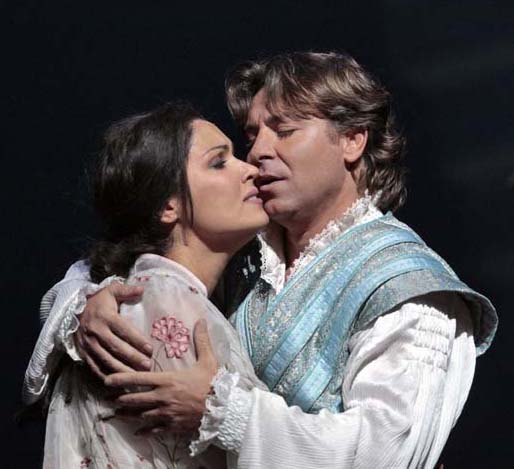Key Word Search
Multi-Field Search
Browse
Repertory Report
Performers Report
Contacts
Met Opera Website
Roméo et Juliette
Metropolitan Opera House, Tue, September 25, 2007
Broadcast
Debut : Isabel Leonard
Roméo et Juliette (312)
Charles Gounod | Jules Barbier/Michel Carré
- Roméo
- Roberto Alagna
- Juliette
- Anna Netrebko
- Frère Laurent
- Kristinn Sigmundsson
- Stéphano
- Isabel Leonard [Debut]
- Mercutio
- Stéphane Degout
- Benvolio
- Tony Stevenson
- Gertrude
- Jane Bunnell
- Capulet
- John Hancock
- Tybalt
- Marc Heller
- Pâris
- Louis Otey
- Grégorio
- David Won
- Duke of Verona
- Dean Peterson
- Conductor
- Plácido Domingo
- Production
- Guy Joosten
- Set Designer
- Johannes Leiacker
- Costume Designer
- Jorge Jara
- Lighting Designer
- David Cunningham
- Choreographer
- Seán Curran
Broadcast live on Sirius Metropolitan Opera Radio
Roméo et Juliette received eleven performances this season
Production photos of Romeo et Juliette by Ken Howard/Metropolitan Opera.
Review 1:
Review of John W. Freeman in December 2007 issue of OPERA NEWS
Anna Netrebko sang her first Met Juliette in the September 25 revival of the company's "Roméo et Juliette" (new two seasons ago), with Roberto Alagna replacing the indisposed Rolando Villazón as Roméo. Plácido Domingo, himself a veteran Roméo, conducted the generally stylish performance, though a more energized kind of suavity wouldn't have been amiss in the slower sections, and coordination between stage and pit sometimes lagged.
"One of the incurable delusions of the musical world," Ernest Newman once wrote, "is that 'Roméo and Juliet' is ideal material for an opera.... Even in opera, one looks for some development of character... and the lovers of Verona do not develop. It is events that develop, not they." Guy Joosten's production does address this problem: the young lovers behave coltishly at first, then do some fast growing up as the forces of destiny bear down. After her flighty waltz song, Netrebko responded with exultant spontaneity to her first meeting with Roméo, and the pair playfully enacted a charade of the death awaiting them. Later, she darkened her tone with foreboding when she learned her unknown suitor was a family foe. From then on, her rapture was tempered with a touch of more mature sensuality. Though her French was mostly opaque, Netrebko's tone remained rich and clear, while her soaring phrases did Gounod's music proud, as did her quasi-balletic stage mobility.
With his intriguing touch of vocal huskiness, Alagna introduced the balcony scene with an "Ah! lève-toi, soleil!" of resonant fiber and poise, sustaining the legato with a steady flow, arching his phrases with aplomb. The four duets of the opera, with their gradually deepening seriousness of tone, showed the pair well matched in timbre and dramatic intent. Alagna expressively voiced Roméo's struggle between despair at the ironic turn of events and sheer joy at finding Juliette still alive. At the very end, after crying out "Ah! Fortuné poignard, ton secours me reste!" as she spied Roméo's dagger and struck herself, Netrebko turned ethereally soft for her next line, "Ce moment est doux," giving the opera one last twist of effective contrast.
Gounod left the other characters little to work with, though there's a glimmer of esprit to his Stéphano and Mercurio, played as close to the hilt as the score allows by Isabel Leonard (in her Met debut) and Stéphane Degout. Interesting in mezzo timbre, striking in person, Leonard, a recent Juililard graduate, dealt brightly and securely with the dodges and leaps of "Que fais-tu, blanche tourterelle," the page's taunting Act III ballad that provokes a melée and sends the tragedy downhill. Degout, sharing with Alagna the most authentic French sound of the evening, tossed off "Mab, la reine des mensonges" with debonair panache in Act I and conveyed fatal impulsiveness in Act III. Jane Bunnell made the most of the few points left to her as Juliette's nurse, Gertrude. John Hancock sounded more woolly than demanding as the girl's father, Capulet, leaving the opera's only bits of paternal kindness to the bemused Frère Laurent of Kristinn Siegmundsson.
"Roméo and Juliette meet perpetually and endlessly about the sun, the moon and the stars.... I find at least twenty or twenty-five apostrophes to the stars of day or night," wrote Ludovic Halévy testily after the premiere in 1867. In the Met's production, Johannes Leiacker's design leaves the stage relatively clear, using changing backgrounds to focus on the firmament, which predicts or reflects the course of events - with a total eclipse, for example, during the melée scene. Against this celestial field, the trajectory of the star-crossed lovers streaked gracefully, but meteorically, leaving them just time to grow into awareness of their destiny.
Search by season: 2007-08
Search by title: Roméo et Juliette,
Met careers
- Plácido Domingo [Conductor]
- Roberto Alagna [Roméo]
- Anna Netrebko [Juliette]
- Kristinn Sigmundsson [Frère Laurent]
- Isabel Leonard [Stéphano]
- Stéphane Degout [Mercutio]
- Tony Stevenson [Benvolio]
- Jane Bunnell [Gertrude]
- John Hancock [Capulet]
- Marc Heller [Tybalt]
- Louis Otey [Pâris]
- David Won [Grégorio]
- Dean Peterson [Duke of Verona]
- Guy Joosten [Production]
- Johannes Leiacker [Set Designer]
- Jorge Jara [Costume Designer]
- Seán Curran [Choreographer]
- David Cunningham [Lighting Designer]
